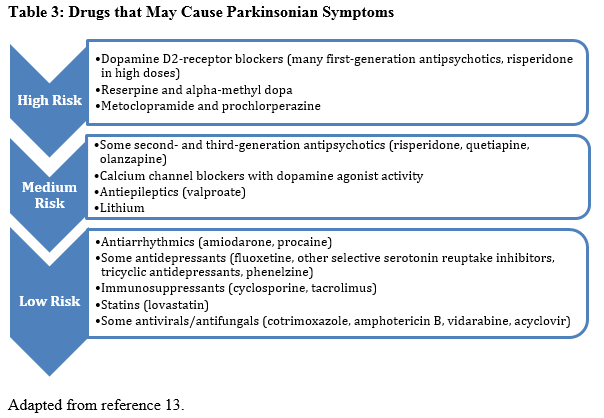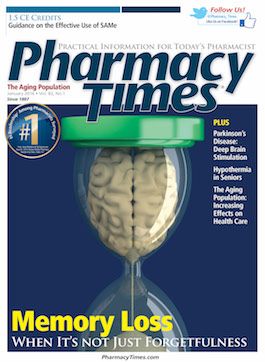Publication
Article
Pharmacy Times
Parkinson's Disease: Deep Brain Stimulation
The intractable, neurodegenerative movement disorder Parkinson's disease has challenged clinicians since its identification in 1817.
The intractable, neurodegenerative movement disorder Parkinson’s disease (PD) has challenged clinicians since its identification in 1817.1 Patients cycle between “on time” when medication is effective, “off time” when symptoms do not respond to medication, and dyskinesia (involuntary movements caused by peak medication levels). Although there is no cure, clinicians usually have fairly good luck controlling initial symptoms with levodopa and dopaminergic agonists.1 (To a certain degree, it is “luck,” as it takes trial and error to find the perfect combination of drugs and dosages for patients.) Over time, patients’ clinical picture worsens, necessitating many medication changes, and increased dosages to control symptoms.1
Deep Brain Stimulation
In PD, dopamine-producing nerve cells in the substantia nigra degenerate, causing tremors, stiffness, slowed movement, and loss of coordination. Levodopabased therapy is the building block for management.2 Patients who experience persistent PD symptoms, despite optimal medication management, may turn to surgery, which first became available in the 1960s. Early PD surgeries (pallidotomy, thalamotomy, and subthalamotomy) are still used and create irreversible lesions on the brain. The newest surgery is deep brain stimulation (DBS), which causes negligible, reversible3 damage to brain tissue.

The basics of DBS are biologic: specific PD symptoms emanate from different areas of the brain. Physicians determine where to place leads (thin, platinum-iridium wires) based on symptoms (Table 1). Patients whose DBS procedure involves the subthalamic nucleus (STN) experience the most significant medication reductions.1,3,4
DBS’s mechanics are relatively simple: a surgeon inserts 1 or more leads into 1 or more specific regions of the patient’s brain. This wire connects to a neurostimulator (pacemaker-like device) implanted in the chest below the collarbone. Once the patient heals, which takes a week or 2, a trained physician or a nurse programs the device externally based on the patient’s symptoms.3,5 The battery-operated device delivers an electrical stimulus to the brain, and the DBS device is adjusted based on patient’s symptoms as often as every 2 weeks,6 balancing stimulation with medication.7
Best Benefit
Good candidates for DBS have3:
- Had symptoms for at least 5 years
- Experienced an appreciable response to PD medications, but poor response duration
- Tried different combinations of PD medications (including adjunct)
- Had symptoms that interfere with daily activities
DBS improves medication-responsive motor symptoms (tremor, rigidity, and bradykinesia) but will not help medication- resistant symptoms (loss of balance, difficulty walking, fatigue, or garbled speech).3,5,8 DBS also lessens druginduced motor complications, including dyskinesia, dystonia, and “on/off” fluctuations.3,5 Used with medication, DBS increases patients’ symptom-free period by an average of 5 hours daily.1 Adjunct medications (selegiline, entacapone, apomorphine, and amantadine) can often be discontinued as severe motor fluctuations are alleviated.3,5
Managing Expectations
Successful DBS balances stimulation and medication. Most patients remain on PD medications after DBS but receive considerably reduced daily doses.5 The rare patient may be able to stop medications completely.9,10 Neurologists and general practitioners never tell patients that undergoing DBS will allow them to discontinue medication; that is an unrealistic goal.3
Pharmacists can help patients by understanding how surgery and medication are related (Online Table 2). Pharmacists need to remind patients and caregivers to monitor for early changes in cognitive impairment, mood, stroke-like symptoms, and seizures. Postoperative confusion occurs in approximately 10% of patients.5-7,9 Temporary speech dysfunction is common and is usually linked to imbalanced stimulation and medication dosing.5,7 If complications occur, patients need to contact their attending physician.5,7
Table 2: Medication Changes in the Perioperative Period
Time Frame
Medication Considerations
Days before DBS
- Take medications as directed
Day of surgery or the night before
- Skip PD medication during the 12 preoperative hours
During surgery
- Patient will be awake and unmedicated during the surgery so the surgeon can pinpoint the optimal location for relieving specific PD symptoms
Immediately after DBS
- Continue at the same levodopa equivalent dose as early as possible after discharge until neurostimulator programming sessions begin
- This decreases risk of dopaminergic withdrawal and malignant hyperthermia
Once stimulation adjustment begins
- Hold medications the night before programming to differentiate symptoms from adverse effects of medication
DBS = deep brain stimulation; PD = Parkinson’s disease.Adapted from references 1, 3, and 5.
The First Year
Most medication changes occur within the first weeks to months after DBS. Patients need fewer programming visits as time goes on, and by 1 year, stimulation parameters and medication titration usually stabilize.7 At 3 years, most patients’ total daily levodopa equivalent dose is 45% to 57% lower than at baseline. About one-third of patients can control symptoms with monotherapy, and approximately 7.5% of patients are medication-free.6,10
Eventually, PD progresses and the effectiveness of DBS declines.6 In addition, patients need to track their neurostimulator battery life. Battery life depends on the stimulation settings, with higher stimulation using more power. Average battery life is 3 to 5 years.11,12 Low batteries can cause clinical symptoms, and patients need to choose between undergoing another (albeit short 20 minute) surgery to change the battery or reducing the stimulation current to save the battery (an option considered palliative).2
Pharmacists see DBS patients more often after surgery than before surgery. By tracking dose adjustments carefully and helping PD patients stay adherent, pharmacists can be a tremendous help to the interdisciplinary team. In addition, pharmacists need to watch for medications that cause drug-induced Parkinsonism (Online Table 3) and alert the lead prescriber.

End Note
Although some patients become medication-free, many researchers believe that complete cessation of antiparkinsonian treatment after DBS can contribute to depression and apathy. Because patients with PD are already predisposed to these disorders, patients, caregivers, and clinicians need to be vigilant.9,10 Pharmacists also need to watch for mental health decline.
Ms. Wick is a visiting professor at the University of Connecticut School of Pharmacy. Ms. Hutchinson is a student who will graduate in 2016.
References
- Medtronic DBS therapy for Parkinson's disease and essential tremor clinical summary, 2013. Medtronic website. http://manuals.medtronic.com/wcm/groups/mdtcom_sg/@emanuals/@era/@neuro/documents/documents/contrib_181407.pdf. Accessed September 26, 2015.
- Asakawa T, Fang H, Hong Z, Sugiyama K, Nozaki T, Namba H. Peripheral stimulation in treating Parkinson's disease: is it a realistic idea or a romantic whimsicality? Intractable Rare Dis Res. 2012;1(4):144-150. doi:10.5582/irdr.2012.v1.4.144.
- Rodriguez RL, Fernandez HH, Haq I, Okun MS. Pearls in patient selection for deep brain stimulation. Neurologist. 2007;13(5):253-260.
- Stefani A, Fedele E, Galati S, et al. Deep brain stimulation in Parkinson's disease patients: biochemical evidence. J Neural Transm Suppl. 2006;(70):401-408.
- Okun M, Zeilman P. Parkinson's Disease: Guide to Deep Brain Stimulation Therapy. 2nd ed. Hagerstown, MD: National Parkinson Foundation; 2014. www.parkinson.org/sites/default/files/Guide_to_DBS_Stimulation_Therapy.pdf. Accessed September 20, 2015.
- Zibetti M, Pesare M, Cinquepalmi A, et al. Antiparkinsonian therapy modifications in PD patients after STN DBS: a retrospective observational analysis. Parkinsonism Rela Disord. 2008;14(8):608-612. doi:10.1016/j.parkreldis.2007.12.009.
- Deuschl G, Herzog J, Kleiner-Fisman G, et al. Deep brain stimulation: postoperative issues. Mov Disord. 2006;21(S14):S219-S237. doi:10.1002/mds.20957.
- Kluger BM, Parra V, Jacobson C, et al. The prevalence of fatigue following deep brain stimulation surgery in Parkinson's disease and association with quality of life. Parkinson’s Dis. 2012;2012:769506. doi:10.1155/2012/769506.
- Patel T, Chang F. Practice recommendations for Parkinson's disease: assessment and management by community pharmacists. Can Pharm J (Ott). 2015;148(3):142-149. doi:10.1177/1715163515578146.
- Alexoudi A, Shalash A, Knudsen K, et al. The medical treatment of patients with Parkinson's disease receiving subthalamic neurostimulation. Parkinsonism Rela Disord. 2015;21(6):555-560. doi:10.1016/j.parkreldis.2015.03.003.
- Tracking your battery life. Medtronic website. www.dbsprogramming.com/2014/06/15/tracking-dbs-battery-life/. Accessed September 15, 2015.
- Fakhar K, Hastings E, Butson CR, Foote KD, Zeilman P, Okun MS. Management of deep brain stimulator battery failure: battery estimators, charge density, and importance of clinical symptoms. PLoS One. 2013;8(3):e58665. doi: 10.1371/journal.pone.0058665.
- Bohlega SA, Al-Foghom NB. Drug-induced Parkinson’s disease. a clinical review. Neurosciences (Riyadh). 2013;18(3):215-221.







